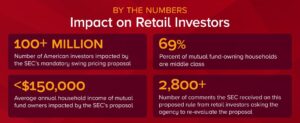The swing-pricing rule the SEC proposed in November demonstrated its potential impact on the fund industry by dominating the conversation at the Investment Company Institute’s (ICI) annual Investment Management Conference last month.
The broad scope of the proposal and the potential for trouble speakers saw in its requirement, especially its imposition of mandatory swing pricing, changes to liquidity classifications and a daily hard close for all U.S. fund investments, overflowed sessions dedicated to the proposal and popped up, usually as a negative example, in other sessions during the regulation-focused agenda of the conference, which took place March 19-22 in Palm Desert, Calif.
The ICI left governance, growth, new product development and other typical IMC topics off the agenda to focus on the challenges facing asset managers and fund boards due to the racing pace of SEC regulatory changes.
ICI president and CEO Eric Pan talked in his opening address about the difficulties posed by changes to the fund naming rule and the recent outsourcing proposal but called the swing pricing rule “the most worrisome of all.”
“The proposal is breathtaking in scope, and it’s no exaggeration to say that it represents the most significant transformation of the mutual fund industry in generations,” he said.
Pan described ICI’s effort to oppose the advancement of the rule, or mitigate its worst aspects, efforts that included public statements with simple explanations about the negative impact on investors and a warning from the Independent Directors Council (IDC) about the creation of “second-class” investors and the potential to drive investors away from traditional funds.
ICI and IDC also encouraged an informal campaign that helped boost the number of public comments posted about the swing-pricing rule above 3,000, including the “unprecedented” collection of comments letters from more than 30 fund boards.
Fund directors are struggling to understand why the SEC is pushing so hard on its whole list of regulatory changes, especially the swing pricing proposal, which seems to have been motivated partly because U.S. funds had not chosen to use it voluntarily, according to Paulita Pike, partner at Ropes & Gray, who works primarily as counsel to fund boards and spoke on a March 20 conference panel about the pace of SEC rulemaking.
“In fact, directors exercise their business judgment every day and, if swing pricing wasn’t implemented, there may be reasons other than just that somebody didn’t want to do it,” she said.
Among the biggest problems is the hard-close requirement that would shut off transactions for U.S. funds at 4 p.m. ET every day regardless of the time zone affecting either the fund or the investor.
“That would make it difficult or impossible for regular investors to trade and receive timely pricing in response to market events,” Pan said.
For those living further West, “the cut-off for daily trading would likely come before most people on the West Coast even get out of bed, ” Pan said. “That’s 50 million or more Americans at risk of being left behind – every single day.”
The hard close and changes in liquidity classifications, both of which could result in shareholders being treated differently based on where they live or in how they invest, is troubling to many directors, Pike said, as is the expected reduction in choices available to investors due to the proposed changes in liquidity cl
assification.
“That’s just for the sake of choice,” Pike said. “Not everything one could choose is a good idea, but there are products today that have served investors well that have not had any issues but would be in peril with the elimination of one of the liquidity buckets.”
In addition to the access problem caused by the hard close, the application of swing pricing to a range of open-ended funds, regardless of size or circumstance, could confuse investors who find out after a transaction that the swing factor meant they got a different price than the one they agreed to, which could put them

Source: ICI
off mutual funds altogether, according to a comment letter the IDC filed in response to the proposal.
“The effect would be to drive investors away from a shareholder-centric investment product that is subject to stringent regulation, comprehensive disclosure requirements, and independent board oversight,” the IDC comment read. “IDC urges the Commission not to move forward with the proposal.”
IMC speaker objections “You don’t have to tear down a house to fix a squeaky door,” Lisa Shea, SVP at Northern Trust said during a panel discussion of the proposal March 21. “You have to go beyond what looks good on the page and think about the practical implications,” Shea said. “Will it really work perfectly? We won’t know until we think through the implications and see where you’re hitting something you don’t mean to hit. Read the comments, but pay attention to the details, not just the argument, so you can think through what the impact will be.” The assumption in the rule proposal that widespread use of swing pricing in Europe proves its validity is wrong, for one thing, according to Erin Kennedy, senior counsel at Dodge & Cox, during the same panel discussion. More EU and U.K. funds use swing pricing than don’t, but it is still optional and discretionary, so risk managers at those funds are using some of the same techniques as U.S. funds, Kennedy said. The size of the U.S. market makes it more difficult to use swing pricing, simply because there are more time zones in the U.S. that influence when, as well as how, a fund would determine its net asset value (NAV) and whether a swing factor should be applied to any outflow, she said. “There is a lot of false precision in some of these very prescriptive proposals,” said Jason Kadavy, senior vice president of fund administration at Voya Investment Management while speaking on the swing-pricing panel. “[The SEC] seems to throw a lot of ideas out there that sound better as guidelines, not necessarily as hard rules. We need more engagement and flexibility. They need to take a step back and let risk managers inform their rulemaking a bit.” “There is no one-size-fits-all,” Kadavy said. There is a lot of one-size-doesn’t-fit-most, however, especially considering that a hard close set at 4 p.m. ET would cut off a big part of the U.S. population who are accustomed to making investment decisions on their own time, Kennedy said. “Our investor population has the advantage of a full day’s trading, so when you throw in this hard close, it’s not about [portfolio managers] anymore; it’s about taking something away the investing public has had for years,” Kennedy said. Panelists argued the hard close will introduce a delay that will make it difficult for investors to balance their portfolios among several different funds or asset types as well, reducing their ability to maximize returns, adding costs and forcing investors to make decisions based on a price that may change later due to the swing factor. “How do I know when it’s time to reallocate [among funds]? If I don’t have a NAV in hand, I can’t do that. If I’m moving between funds, I could be out of the market day,” she said. “Even if we call it a swing price or call it an antidilution measure, to the investing public this may just seem like another fee they don’t understand and don’t know when it’s going to be applied,” Kennedy said. Former SEC staffers speaking at the IMC urged attendees to continue making their detailed objections known to the SEC through public comments, individual meetings or public gatherings like the IMC on the assumption the SEC staff will use practical information on market operations to reduce the potential negative impact and costs of the rule before presenting it for a final vote of the commission.
Most IMC speakers described the proposal as unnecessary and unjustified by available evidence, too deeply flawed to implement, or urged the SEC to study the thousands of submitted comments in detail to identify the problems that make the original version of the rule almost impossible to implement, even if it were not completely inappropriate for the problem it is supposed to address.
